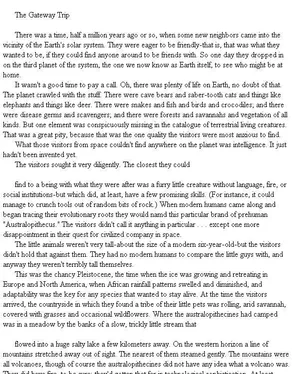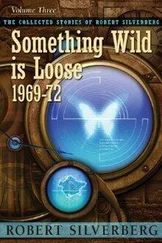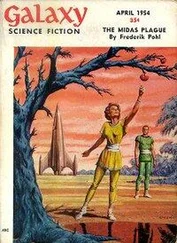Pohl, Frederik - The Gateway Trip
Здесь есть возможность читать онлайн «Pohl, Frederik - The Gateway Trip» весь текст электронной книги совершенно бесплатно (целиком полную версию без сокращений). В некоторых случаях можно слушать аудио, скачать через торрент в формате fb2 и присутствует краткое содержание. Жанр: Старинная литература, на английском языке. Описание произведения, (предисловие) а так же отзывы посетителей доступны на портале библиотеки ЛибКат.
- Название:The Gateway Trip
- Автор:
- Жанр:
- Год:неизвестен
- ISBN:нет данных
- Рейтинг книги:4 / 5. Голосов: 1
-
Избранное:Добавить в избранное
- Отзывы:
-
Ваша оценка:
- 80
- 1
- 2
- 3
- 4
- 5
The Gateway Trip: краткое содержание, описание и аннотация
Предлагаем к чтению аннотацию, описание, краткое содержание или предисловие (зависит от того, что написал сам автор книги «The Gateway Trip»). Если вы не нашли необходимую информацию о книге — напишите в комментариях, мы постараемся отыскать её.
The Gateway Trip — читать онлайн бесплатно полную книгу (весь текст) целиком
Ниже представлен текст книги, разбитый по страницам. Система сохранения места последней прочитанной страницы, позволяет с удобством читать онлайн бесплатно книгу «The Gateway Trip», без необходимости каждый раз заново искать на чём Вы остановились. Поставьте закладку, и сможете в любой момент перейти на страницу, на которой закончили чтение.
Интервал:
Закладка:
For the first time in human history, men walked on the surface of a heavenly body that was not part of the Sun's entourage.
First impressions were a bit disappointing. The four-power party discovered quickly enough that the planet had had some bad times. Its surface was seared, as though by great heat, and parts of it made their radiation detectors squeal. They knew they could not stay there long. But a mile or less from the lander, down a barren slope from the mountaintop mesa where they had landed, they found some rock and metal formations that looked artificial, and poking around them they dug up three items they thought worth bringing home. One was a flat tile with a triangular design still visible on its
glazed surface. The second was a ceramic object about the size of a cigar, with thread markings-a bolt? The third was a yard-long metal cylinder, made of chromium and pierced with a couple of holes; it could have been a musical instrument, or part of a machine-even a Hilsch tube.
Whatever they were, they were artifacts.
When the four-power crew proudly displayed their trophies back on the Gateway asteroid, they created an immense stir. None of the three looked like a major technological breakthrough. Nevertheless, if such things could be found, then there were certainly others-and no doubt things that would be of a lot more practical value.
That was when the interstellar gold rush began in earnest.
It was a long time before anyone got that lucky again. Overall, the statistics on missions out of the Gateway asteroid showed that four out of five trips came back with nothing to show but some pictures and instrument readings. Fifteen percent never came back at all. It was only one ship out of twenty that brought back any tangible piece of Heechee technology, and most of those things were
only curiosities-but the very few that were more than curiosities were treasures beyond price.
They were few and far between, to be sure. The exploration of Venus had shown that was probable, for in all the hundreds of miles of Heech~e tunnels under the surface of the planet Venus no more than a dozen gadgets had been found.
To be sure, some of those meant big profits for those who learned to copy them. The anisokinetic punch was a marvel. Hammer it on one end, and the force of the blow came out at the side. What was even more marvelous was that scientists managed to figure out how it worked, and its principle had applications in every area of construction, manufacture, and even home repair. The fire-pearls were a mystery. So were the so-called prayer fans.
Then, of course, humans reached the Gateway asteroid, and that fleet of ships was the biggest treasure trove of all. But all there was on the asteroid were the ships themselves. The ships were empty of anything but their operating gear. The whole asteroid was empty, almost surgically clean . . . as though the Heechee had deliberately left the ships but removed everything else that could be of value.
Over a period of twenty years and more the Gateway explorers went out to seek whatever could be found. They came back with pictures and stories, and kinds of living things and minerals; but of Heechee artifacts they found very few.
That was why so many Gateway prospectors died poor-or just died.
MISSION TOOLBOX
Some also died rich, without knowing they had become rich. That was the case in one of the biggest finds. Unfortunately, it did three of its five discoverers little good, because they did not survive the trip.
The mission started with three Austrians, two brothers and an uncle, using the last of an inheritance to pay their way to Gateway. They were determined to ship out only in an armored ship. As the only such vessel available was a Five, at the last minute they recruited a South American, Manuel de los Fintas, and an American, Sheri Loffat, to go with them.
They reached a planet; they landed on the planet; they found nothing much there. But their instruments showed Heechee metal somewhere around, and they tracked it down.
It was a lander. It had been abandoned there, heaven knew when. But it was not empty.
The biggest thing they found in the lander was a stack of Heechee metal hexagonal boxes, not more than half a meter across and less than half that tall, weight twenty-three kilograms. They were
tools. Some of the items were familiar, and useless as far as anyone had been able to tell: almost a dozen little prayer fans of the kind that littered so many Heechee tunnels and artifacts. But there were also things like screwdrivers but with flexible shafts; things like socket wrenches but made out of some soft material; things that resembled electrical test probes but turned out to be spare parts for other Heechee machines.
It was a grand success. They wound up millionaires-or, at least, the survivors did.
That find was lying right on the surface of the planet. But before long the Gateway prospectors learned that planet surfaces were not the most likely places to look for examples of Heechee treasures. Under the surface was much, much richer.
One thing was clear early on about the vanished Heechee: they liked tunnels. The Heechee tunnels that honeycombed parts of the planet Venus weren't unique. As explorations retraced the old interstellar trails they found examples of them everywhere the Heechee had gone. The inside of the Gateway asteroid was a maze of tunnels; so were the "other Gateways" that turned up as the explorations progressed. Nearly every planet the Heechee had left any
signs on at all had tunnels dug into it, lined with Heechee metal. Where the surface conditions were unpleasant (as on Venus), the tunnels were extensive and complex. But even so fair a world as Peggy's Planet had a few of them. The anthropologically trained scientists called Heecheeologists, trying passionately to figure out what these vanished people were like, supposed that they came from a burrowing race, like gophers, rather than an arboreal one, like people. The Heecheeologists turned out to be right ... but it was a long time before any of them were sure of it.
All the tunnels looked pretty much alike. They were lined with
a dense, hard, metallic substance that glowed in the dark: it was called Heechee metal. In the first tunnels humans encountered, on Venus and on the Gateway asteroid itself, the glow was a pale blue. Blue was by far the commonest of Heechee-metal colors, but inside the Heechee ships there were some parts that were made of a golden Heechee metal, and later on the explorers found Heechee metal that glowed red or green.
No one really knew why Heechee metal came in different colors. The Heecheeologists were not much help. All they could tell about the occasional variation in the color of Heechee metal was that it seemed clear that the tunnels of bluish metal were generally the ones poorest in Heechee artifacts: Gold, red, and green almost always had more treasures to be found by the explorers.
Of course, until men and women began to learn how to explore the galaxy in the Heechee ships, they were limited to the blue-glowing tunnels of Gateway and Venus. And in them the treasures to be found were sparse, though sometimes of great value. In the tunnels found on the most productive planets, the metal walls started out blue, and then became another color just where the largest collections of useful tools were located. No one knew why ... but then, no one knew much about the Heechee at all, just then.
MISSION HEATER
Wu Fengtse had chosen to ship out in a One. That had its advantages, and its faults. The biggest advantage was that if there was nothing to land on, and the only reward would be some kind of science bonus for observations, he could keep it all himself.
It didn't happen that way, though. When he came out of FTL drive, he found himself in orbit around a more or less Earth-type planet.
Читать дальшеИнтервал:
Закладка:
Похожие книги на «The Gateway Trip»
Представляем Вашему вниманию похожие книги на «The Gateway Trip» списком для выбора. Мы отобрали схожую по названию и смыслу литературу в надежде предоставить читателям больше вариантов отыскать новые, интересные, ещё непрочитанные произведения.
Обсуждение, отзывы о книге «The Gateway Trip» и просто собственные мнения читателей. Оставьте ваши комментарии, напишите, что Вы думаете о произведении, его смысле или главных героях. Укажите что конкретно понравилось, а что нет, и почему Вы так считаете.












